Management and Operations: Leadership, Theories and Strategies Report
VerifiedAdded on 2023/01/03
|16
|4145
|82
Report
AI Summary
This report delves into the critical differences between leaders and managers, exploring their roles, characteristics, and applications within different situational contexts. It analyzes various leadership models, including situational, contingency, and system theories, providing a comprehensive understanding of effective leadership styles. The report further examines diverse approaches to operations management, highlighting the roles of leaders and managers in achieving business objectives, and identifying factors that influence operational decision-making. The analysis includes a case study of Morrisons, illustrating how these concepts are applied in a real-world business setting, making it a valuable resource for understanding leadership, management, and operational strategies.
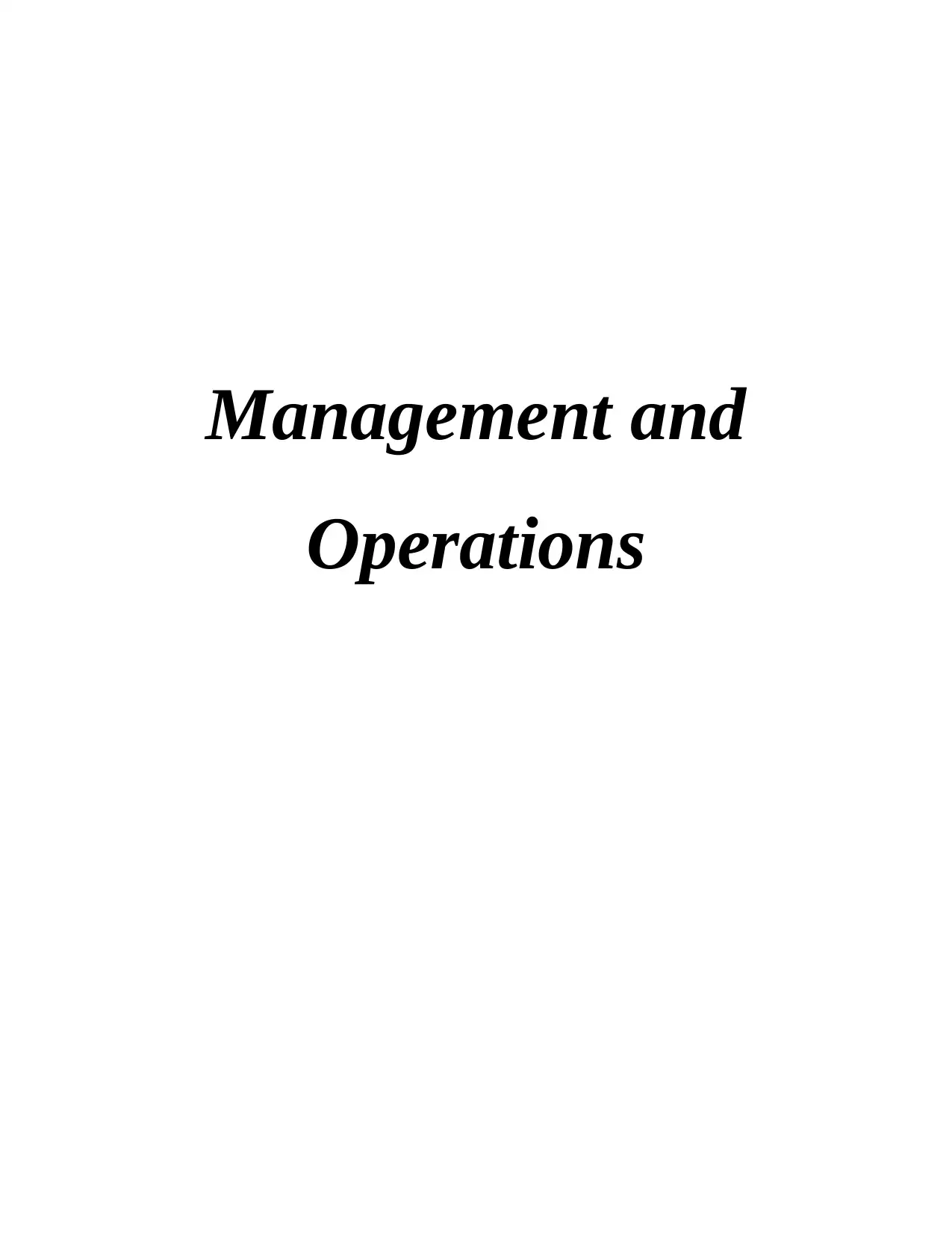
Management and
Operations
Operations
Paraphrase This Document
Need a fresh take? Get an instant paraphrase of this document with our AI Paraphraser
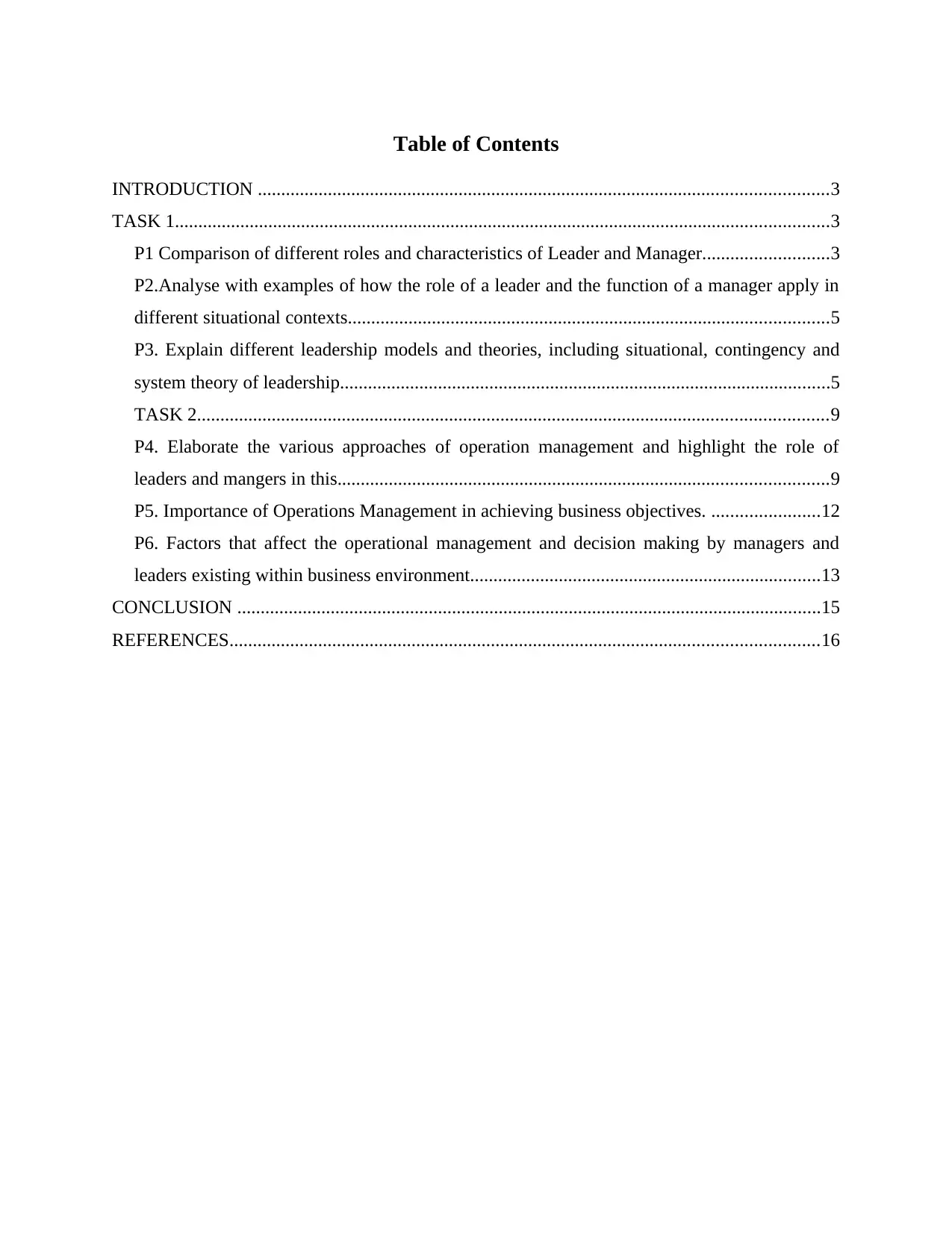
Table of Contents
INTRODUCTION ..........................................................................................................................3
TASK 1............................................................................................................................................3
P1 Comparison of different roles and characteristics of Leader and Manager...........................3
P2.Analyse with examples of how the role of a leader and the function of a manager apply in
different situational contexts.......................................................................................................5
P3. Explain different leadership models and theories, including situational, contingency and
system theory of leadership.........................................................................................................5
TASK 2.......................................................................................................................................9
P4. Elaborate the various approaches of operation management and highlight the role of
leaders and mangers in this.........................................................................................................9
P5. Importance of Operations Management in achieving business objectives. .......................12
P6. Factors that affect the operational management and decision making by managers and
leaders existing within business environment...........................................................................13
CONCLUSION .............................................................................................................................15
REFERENCES..............................................................................................................................16
INTRODUCTION ..........................................................................................................................3
TASK 1............................................................................................................................................3
P1 Comparison of different roles and characteristics of Leader and Manager...........................3
P2.Analyse with examples of how the role of a leader and the function of a manager apply in
different situational contexts.......................................................................................................5
P3. Explain different leadership models and theories, including situational, contingency and
system theory of leadership.........................................................................................................5
TASK 2.......................................................................................................................................9
P4. Elaborate the various approaches of operation management and highlight the role of
leaders and mangers in this.........................................................................................................9
P5. Importance of Operations Management in achieving business objectives. .......................12
P6. Factors that affect the operational management and decision making by managers and
leaders existing within business environment...........................................................................13
CONCLUSION .............................................................................................................................15
REFERENCES..............................................................................................................................16
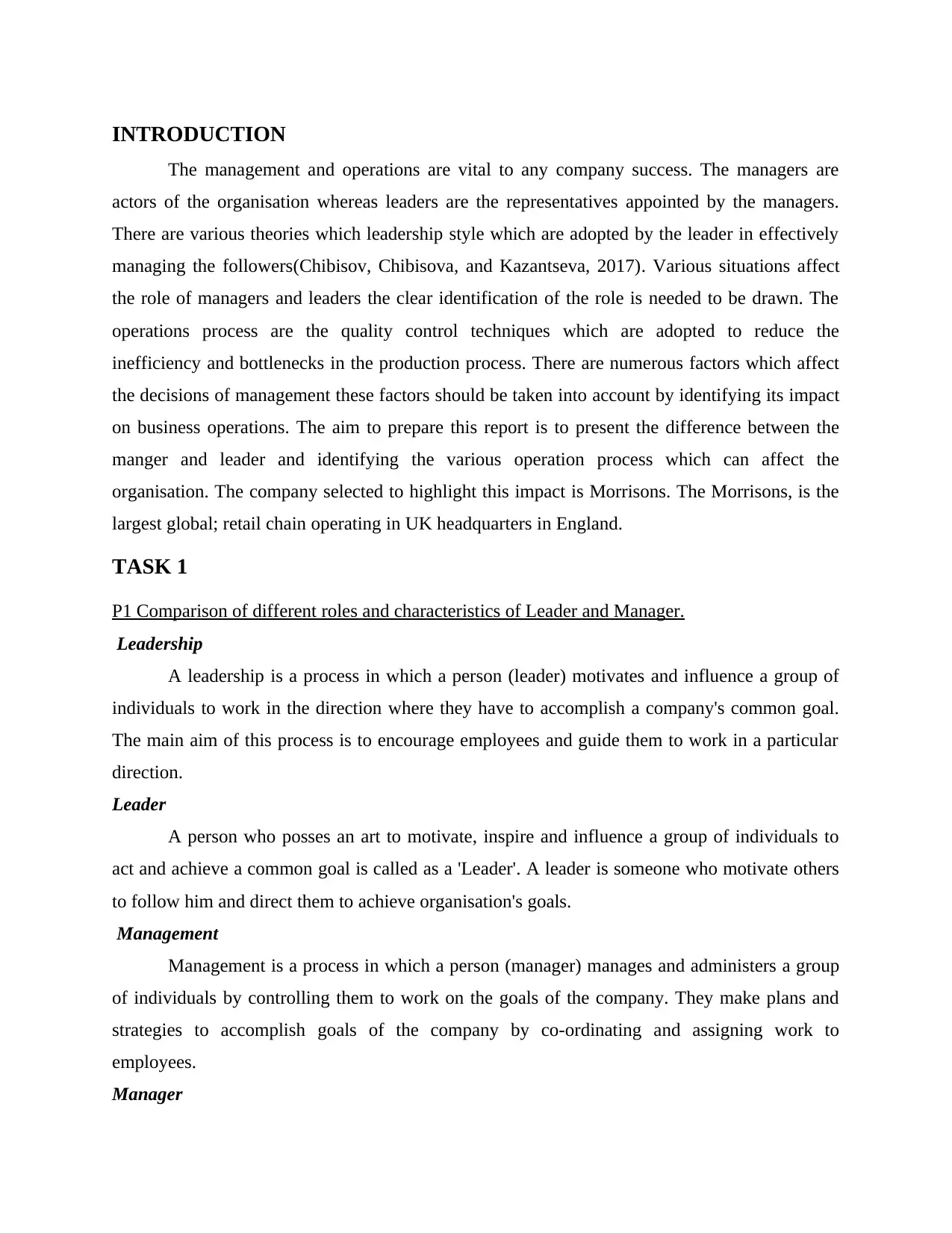
INTRODUCTION
The management and operations are vital to any company success. The managers are
actors of the organisation whereas leaders are the representatives appointed by the managers.
There are various theories which leadership style which are adopted by the leader in effectively
managing the followers(Chibisov, Chibisova, and Kazantseva, 2017). Various situations affect
the role of managers and leaders the clear identification of the role is needed to be drawn. The
operations process are the quality control techniques which are adopted to reduce the
inefficiency and bottlenecks in the production process. There are numerous factors which affect
the decisions of management these factors should be taken into account by identifying its impact
on business operations. The aim to prepare this report is to present the difference between the
manger and leader and identifying the various operation process which can affect the
organisation. The company selected to highlight this impact is Morrisons. The Morrisons, is the
largest global; retail chain operating in UK headquarters in England.
TASK 1
P1 Comparison of different roles and characteristics of Leader and Manager.
Leadership
A leadership is a process in which a person (leader) motivates and influence a group of
individuals to work in the direction where they have to accomplish a company's common goal.
The main aim of this process is to encourage employees and guide them to work in a particular
direction.
Leader
A person who posses an art to motivate, inspire and influence a group of individuals to
act and achieve a common goal is called as a 'Leader'. A leader is someone who motivate others
to follow him and direct them to achieve organisation's goals.
Management
Management is a process in which a person (manager) manages and administers a group
of individuals by controlling them to work on the goals of the company. They make plans and
strategies to accomplish goals of the company by co-ordinating and assigning work to
employees.
Manager
The management and operations are vital to any company success. The managers are
actors of the organisation whereas leaders are the representatives appointed by the managers.
There are various theories which leadership style which are adopted by the leader in effectively
managing the followers(Chibisov, Chibisova, and Kazantseva, 2017). Various situations affect
the role of managers and leaders the clear identification of the role is needed to be drawn. The
operations process are the quality control techniques which are adopted to reduce the
inefficiency and bottlenecks in the production process. There are numerous factors which affect
the decisions of management these factors should be taken into account by identifying its impact
on business operations. The aim to prepare this report is to present the difference between the
manger and leader and identifying the various operation process which can affect the
organisation. The company selected to highlight this impact is Morrisons. The Morrisons, is the
largest global; retail chain operating in UK headquarters in England.
TASK 1
P1 Comparison of different roles and characteristics of Leader and Manager.
Leadership
A leadership is a process in which a person (leader) motivates and influence a group of
individuals to work in the direction where they have to accomplish a company's common goal.
The main aim of this process is to encourage employees and guide them to work in a particular
direction.
Leader
A person who posses an art to motivate, inspire and influence a group of individuals to
act and achieve a common goal is called as a 'Leader'. A leader is someone who motivate others
to follow him and direct them to achieve organisation's goals.
Management
Management is a process in which a person (manager) manages and administers a group
of individuals by controlling them to work on the goals of the company. They make plans and
strategies to accomplish goals of the company by co-ordinating and assigning work to
employees.
Manager
⊘ This is a preview!⊘
Do you want full access?
Subscribe today to unlock all pages.

Trusted by 1+ million students worldwide
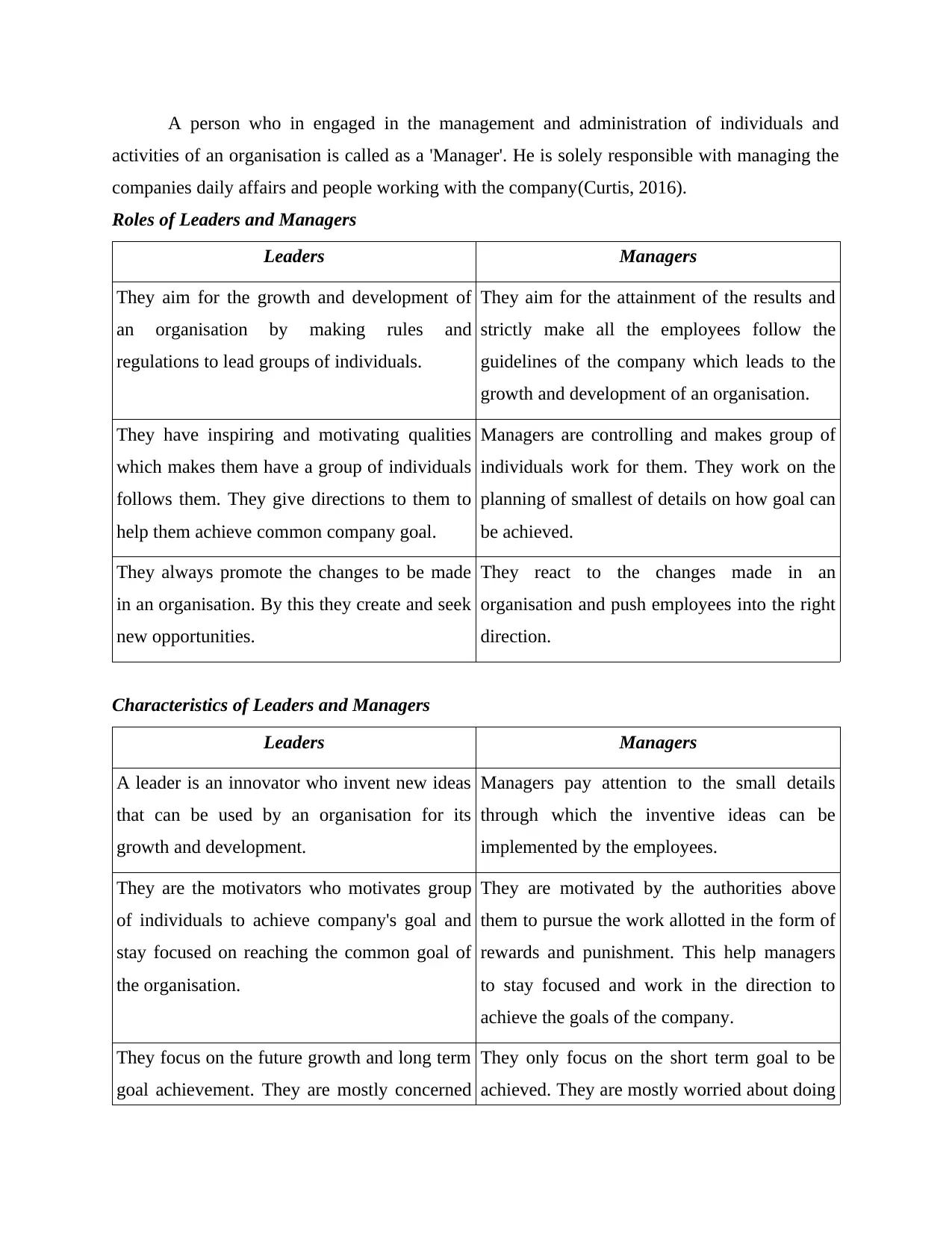
A person who in engaged in the management and administration of individuals and
activities of an organisation is called as a 'Manager'. He is solely responsible with managing the
companies daily affairs and people working with the company(Curtis, 2016).
Roles of Leaders and Managers
Leaders Managers
They aim for the growth and development of
an organisation by making rules and
regulations to lead groups of individuals.
They aim for the attainment of the results and
strictly make all the employees follow the
guidelines of the company which leads to the
growth and development of an organisation.
They have inspiring and motivating qualities
which makes them have a group of individuals
follows them. They give directions to them to
help them achieve common company goal.
Managers are controlling and makes group of
individuals work for them. They work on the
planning of smallest of details on how goal can
be achieved.
They always promote the changes to be made
in an organisation. By this they create and seek
new opportunities.
They react to the changes made in an
organisation and push employees into the right
direction.
Characteristics of Leaders and Managers
Leaders Managers
A leader is an innovator who invent new ideas
that can be used by an organisation for its
growth and development.
Managers pay attention to the small details
through which the inventive ideas can be
implemented by the employees.
They are the motivators who motivates group
of individuals to achieve company's goal and
stay focused on reaching the common goal of
the organisation.
They are motivated by the authorities above
them to pursue the work allotted in the form of
rewards and punishment. This help managers
to stay focused and work in the direction to
achieve the goals of the company.
They focus on the future growth and long term
goal achievement. They are mostly concerned
They only focus on the short term goal to be
achieved. They are mostly worried about doing
activities of an organisation is called as a 'Manager'. He is solely responsible with managing the
companies daily affairs and people working with the company(Curtis, 2016).
Roles of Leaders and Managers
Leaders Managers
They aim for the growth and development of
an organisation by making rules and
regulations to lead groups of individuals.
They aim for the attainment of the results and
strictly make all the employees follow the
guidelines of the company which leads to the
growth and development of an organisation.
They have inspiring and motivating qualities
which makes them have a group of individuals
follows them. They give directions to them to
help them achieve common company goal.
Managers are controlling and makes group of
individuals work for them. They work on the
planning of smallest of details on how goal can
be achieved.
They always promote the changes to be made
in an organisation. By this they create and seek
new opportunities.
They react to the changes made in an
organisation and push employees into the right
direction.
Characteristics of Leaders and Managers
Leaders Managers
A leader is an innovator who invent new ideas
that can be used by an organisation for its
growth and development.
Managers pay attention to the small details
through which the inventive ideas can be
implemented by the employees.
They are the motivators who motivates group
of individuals to achieve company's goal and
stay focused on reaching the common goal of
the organisation.
They are motivated by the authorities above
them to pursue the work allotted in the form of
rewards and punishment. This help managers
to stay focused and work in the direction to
achieve the goals of the company.
They focus on the future growth and long term
goal achievement. They are mostly concerned
They only focus on the short term goal to be
achieved. They are mostly worried about doing
Paraphrase This Document
Need a fresh take? Get an instant paraphrase of this document with our AI Paraphraser
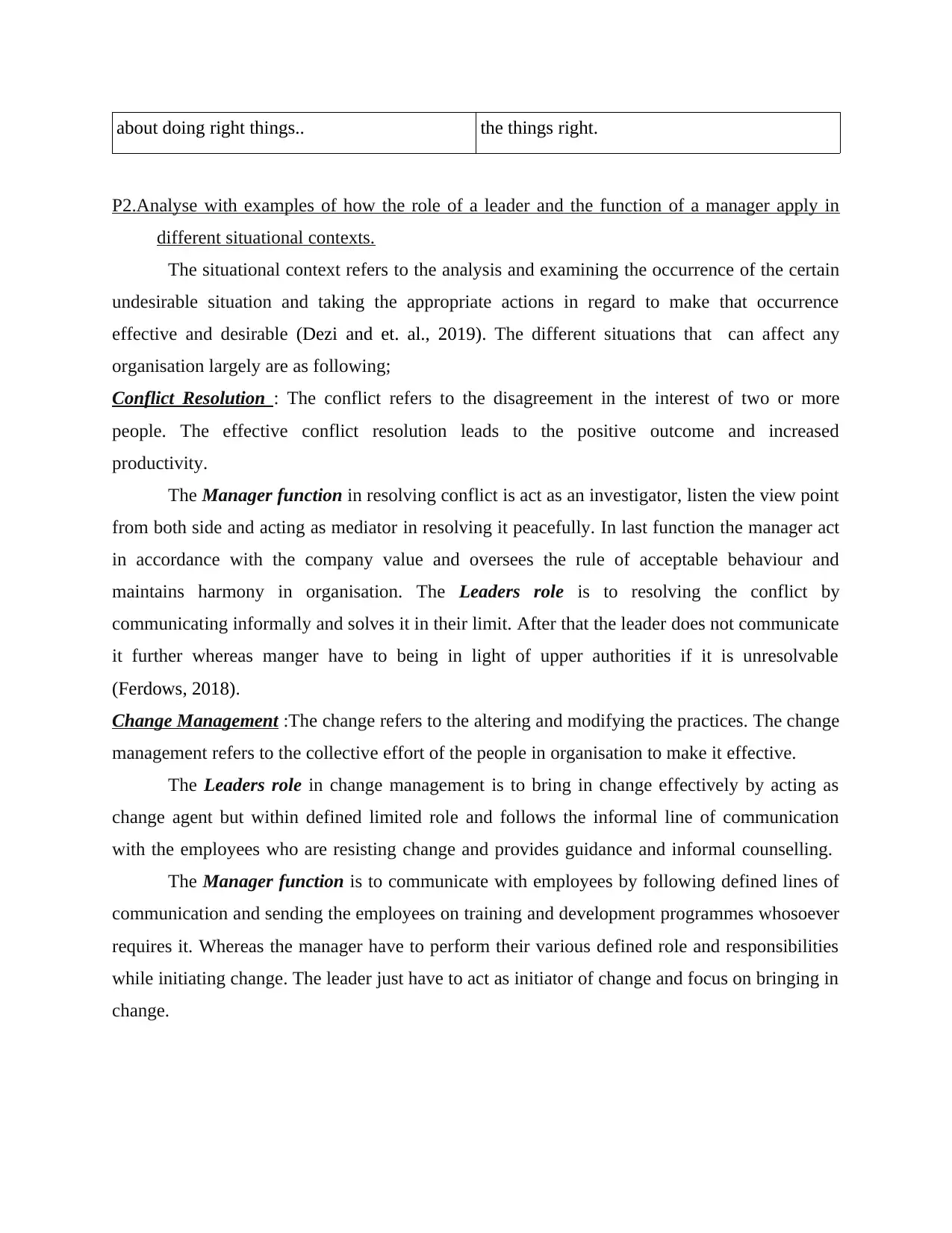
about doing right things.. the things right.
P2.Analyse with examples of how the role of a leader and the function of a manager apply in
different situational contexts.
The situational context refers to the analysis and examining the occurrence of the certain
undesirable situation and taking the appropriate actions in regard to make that occurrence
effective and desirable (Dezi and et. al., 2019). The different situations that can affect any
organisation largely are as following;
Conflict Resolution : The conflict refers to the disagreement in the interest of two or more
people. The effective conflict resolution leads to the positive outcome and increased
productivity.
The Manager function in resolving conflict is act as an investigator, listen the view point
from both side and acting as mediator in resolving it peacefully. In last function the manager act
in accordance with the company value and oversees the rule of acceptable behaviour and
maintains harmony in organisation. The Leaders role is to resolving the conflict by
communicating informally and solves it in their limit. After that the leader does not communicate
it further whereas manger have to being in light of upper authorities if it is unresolvable
(Ferdows, 2018).
Change Management :The change refers to the altering and modifying the practices. The change
management refers to the collective effort of the people in organisation to make it effective.
The Leaders role in change management is to bring in change effectively by acting as
change agent but within defined limited role and follows the informal line of communication
with the employees who are resisting change and provides guidance and informal counselling.
The Manager function is to communicate with employees by following defined lines of
communication and sending the employees on training and development programmes whosoever
requires it. Whereas the manager have to perform their various defined role and responsibilities
while initiating change. The leader just have to act as initiator of change and focus on bringing in
change.
P2.Analyse with examples of how the role of a leader and the function of a manager apply in
different situational contexts.
The situational context refers to the analysis and examining the occurrence of the certain
undesirable situation and taking the appropriate actions in regard to make that occurrence
effective and desirable (Dezi and et. al., 2019). The different situations that can affect any
organisation largely are as following;
Conflict Resolution : The conflict refers to the disagreement in the interest of two or more
people. The effective conflict resolution leads to the positive outcome and increased
productivity.
The Manager function in resolving conflict is act as an investigator, listen the view point
from both side and acting as mediator in resolving it peacefully. In last function the manager act
in accordance with the company value and oversees the rule of acceptable behaviour and
maintains harmony in organisation. The Leaders role is to resolving the conflict by
communicating informally and solves it in their limit. After that the leader does not communicate
it further whereas manger have to being in light of upper authorities if it is unresolvable
(Ferdows, 2018).
Change Management :The change refers to the altering and modifying the practices. The change
management refers to the collective effort of the people in organisation to make it effective.
The Leaders role in change management is to bring in change effectively by acting as
change agent but within defined limited role and follows the informal line of communication
with the employees who are resisting change and provides guidance and informal counselling.
The Manager function is to communicate with employees by following defined lines of
communication and sending the employees on training and development programmes whosoever
requires it. Whereas the manager have to perform their various defined role and responsibilities
while initiating change. The leader just have to act as initiator of change and focus on bringing in
change.
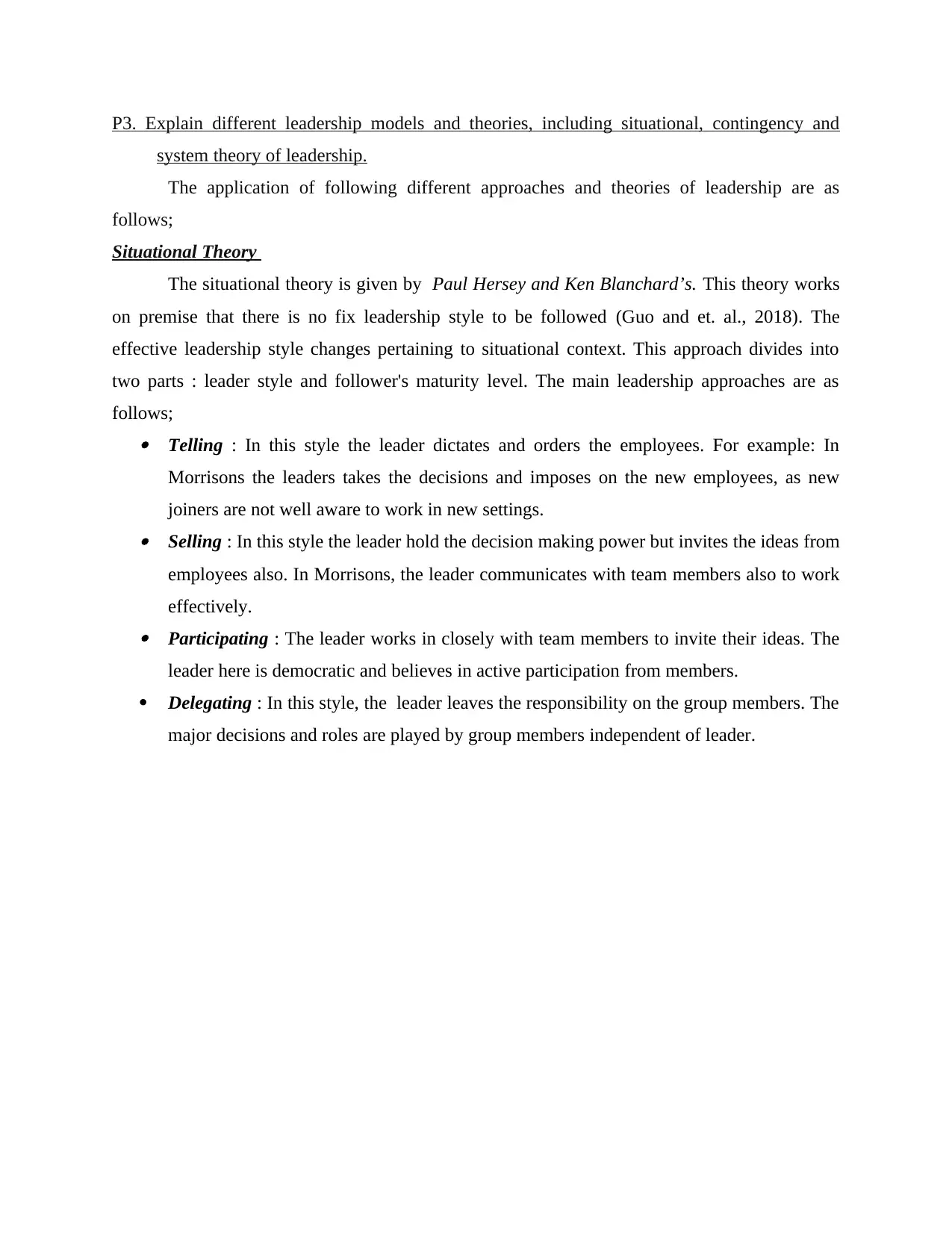
P3. Explain different leadership models and theories, including situational, contingency and
system theory of leadership.
The application of following different approaches and theories of leadership are as
follows;
Situational Theory
The situational theory is given by Paul Hersey and Ken Blanchard’s. This theory works
on premise that there is no fix leadership style to be followed (Guo and et. al., 2018). The
effective leadership style changes pertaining to situational context. This approach divides into
two parts : leader style and follower's maturity level. The main leadership approaches are as
follows; Telling : In this style the leader dictates and orders the employees. For example: In
Morrisons the leaders takes the decisions and imposes on the new employees, as new
joiners are not well aware to work in new settings. Selling : In this style the leader hold the decision making power but invites the ideas from
employees also. In Morrisons, the leader communicates with team members also to work
effectively. Participating : The leader works in closely with team members to invite their ideas. The
leader here is democratic and believes in active participation from members.
Delegating : In this style, the leader leaves the responsibility on the group members. The
major decisions and roles are played by group members independent of leader.
system theory of leadership.
The application of following different approaches and theories of leadership are as
follows;
Situational Theory
The situational theory is given by Paul Hersey and Ken Blanchard’s. This theory works
on premise that there is no fix leadership style to be followed (Guo and et. al., 2018). The
effective leadership style changes pertaining to situational context. This approach divides into
two parts : leader style and follower's maturity level. The main leadership approaches are as
follows; Telling : In this style the leader dictates and orders the employees. For example: In
Morrisons the leaders takes the decisions and imposes on the new employees, as new
joiners are not well aware to work in new settings. Selling : In this style the leader hold the decision making power but invites the ideas from
employees also. In Morrisons, the leader communicates with team members also to work
effectively. Participating : The leader works in closely with team members to invite their ideas. The
leader here is democratic and believes in active participation from members.
Delegating : In this style, the leader leaves the responsibility on the group members. The
major decisions and roles are played by group members independent of leader.
⊘ This is a preview!⊘
Do you want full access?
Subscribe today to unlock all pages.

Trusted by 1+ million students worldwide
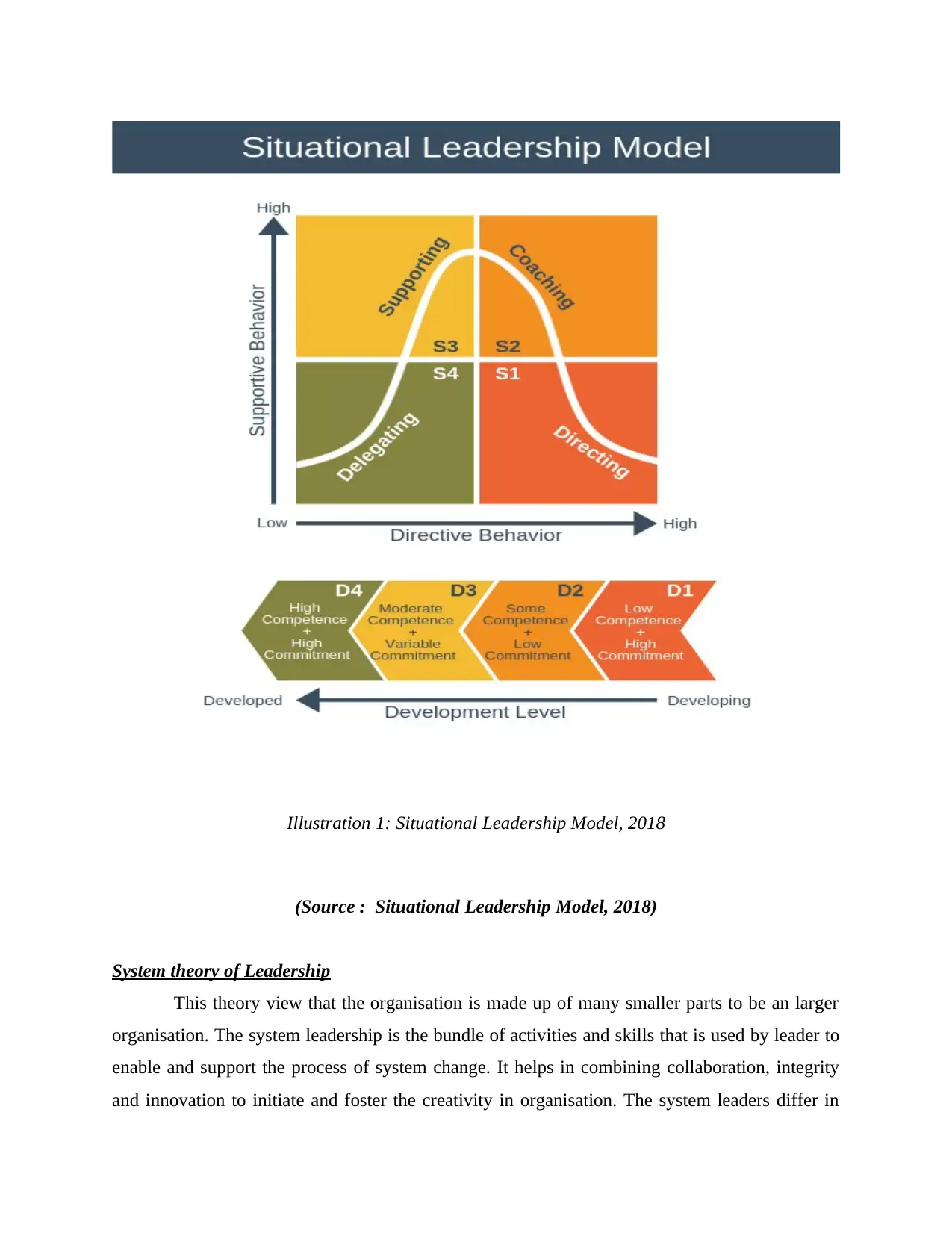
Illustration 1: Situational Leadership Model, 2018
(Source : Situational Leadership Model, 2018)
System theory of Leadership
This theory view that the organisation is made up of many smaller parts to be an larger
organisation. The system leadership is the bundle of activities and skills that is used by leader to
enable and support the process of system change. It helps in combining collaboration, integrity
and innovation to initiate and foster the creativity in organisation. The system leaders differ in
(Source : Situational Leadership Model, 2018)
System theory of Leadership
This theory view that the organisation is made up of many smaller parts to be an larger
organisation. The system leadership is the bundle of activities and skills that is used by leader to
enable and support the process of system change. It helps in combining collaboration, integrity
and innovation to initiate and foster the creativity in organisation. The system leaders differ in
Paraphrase This Document
Need a fresh take? Get an instant paraphrase of this document with our AI Paraphraser
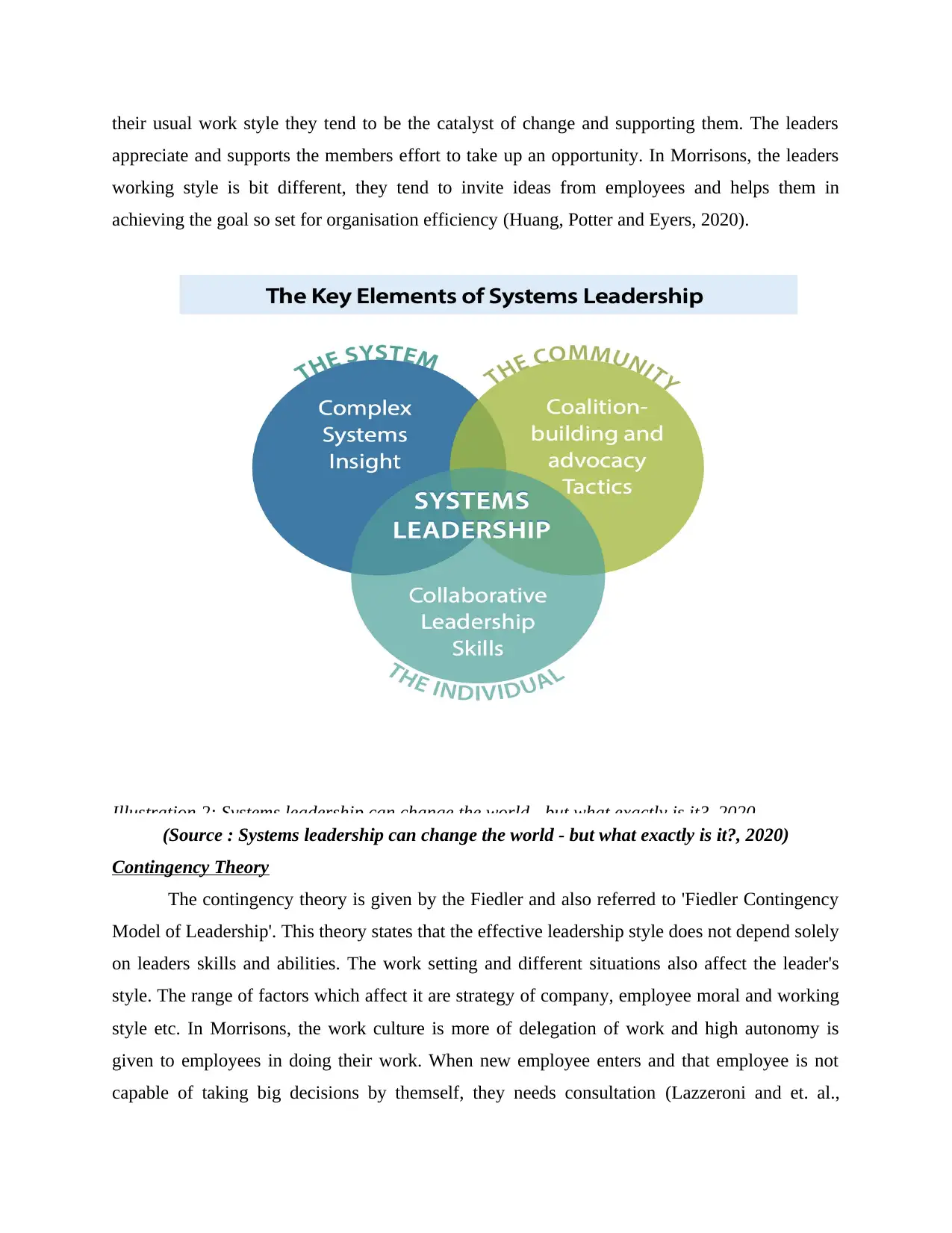
their usual work style they tend to be the catalyst of change and supporting them. The leaders
appreciate and supports the members effort to take up an opportunity. In Morrisons, the leaders
working style is bit different, they tend to invite ideas from employees and helps them in
achieving the goal so set for organisation efficiency (Huang, Potter and Eyers, 2020).
Illustration 2: Systems leadership can change the world - but what exactly is it?, 2020
(Source : Systems leadership can change the world - but what exactly is it?, 2020)
Contingency Theory
The contingency theory is given by the Fiedler and also referred to 'Fiedler Contingency
Model of Leadership'. This theory states that the effective leadership style does not depend solely
on leaders skills and abilities. The work setting and different situations also affect the leader's
style. The range of factors which affect it are strategy of company, employee moral and working
style etc. In Morrisons, the work culture is more of delegation of work and high autonomy is
given to employees in doing their work. When new employee enters and that employee is not
capable of taking big decisions by themself, they needs consultation (Lazzeroni and et. al.,
appreciate and supports the members effort to take up an opportunity. In Morrisons, the leaders
working style is bit different, they tend to invite ideas from employees and helps them in
achieving the goal so set for organisation efficiency (Huang, Potter and Eyers, 2020).
Illustration 2: Systems leadership can change the world - but what exactly is it?, 2020
(Source : Systems leadership can change the world - but what exactly is it?, 2020)
Contingency Theory
The contingency theory is given by the Fiedler and also referred to 'Fiedler Contingency
Model of Leadership'. This theory states that the effective leadership style does not depend solely
on leaders skills and abilities. The work setting and different situations also affect the leader's
style. The range of factors which affect it are strategy of company, employee moral and working
style etc. In Morrisons, the work culture is more of delegation of work and high autonomy is
given to employees in doing their work. When new employee enters and that employee is not
capable of taking big decisions by themself, they needs consultation (Lazzeroni and et. al.,
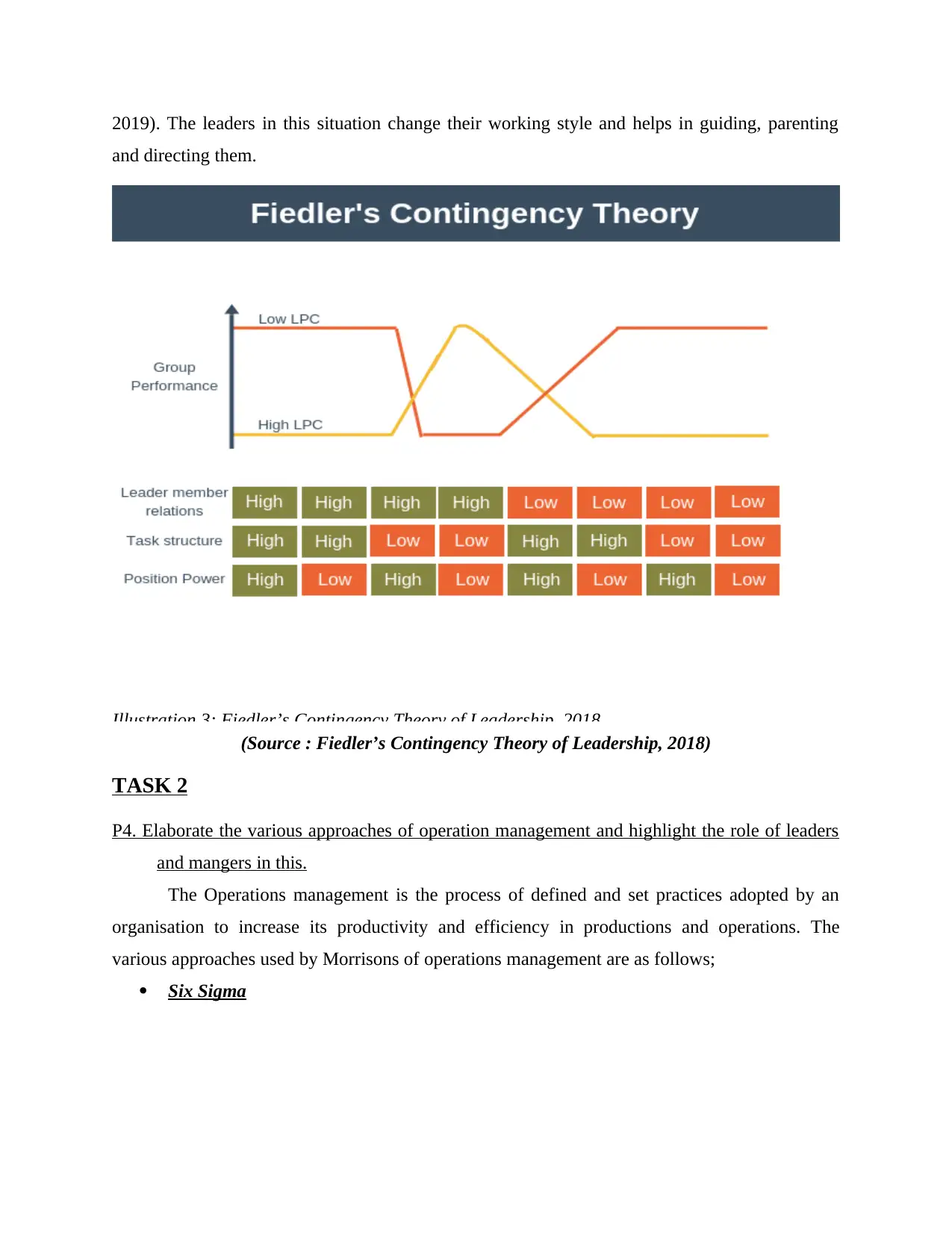
2019). The leaders in this situation change their working style and helps in guiding, parenting
and directing them.
Illustration 3: Fiedler’s Contingency Theory of Leadership, 2018
(Source : Fiedler’s Contingency Theory of Leadership, 2018)
TASK 2
P4. Elaborate the various approaches of operation management and highlight the role of leaders
and mangers in this.
The Operations management is the process of defined and set practices adopted by an
organisation to increase its productivity and efficiency in productions and operations. The
various approaches used by Morrisons of operations management are as follows;
Six Sigma
and directing them.
Illustration 3: Fiedler’s Contingency Theory of Leadership, 2018
(Source : Fiedler’s Contingency Theory of Leadership, 2018)
TASK 2
P4. Elaborate the various approaches of operation management and highlight the role of leaders
and mangers in this.
The Operations management is the process of defined and set practices adopted by an
organisation to increase its productivity and efficiency in productions and operations. The
various approaches used by Morrisons of operations management are as follows;
Six Sigma
⊘ This is a preview!⊘
Do you want full access?
Subscribe today to unlock all pages.

Trusted by 1+ million students worldwide
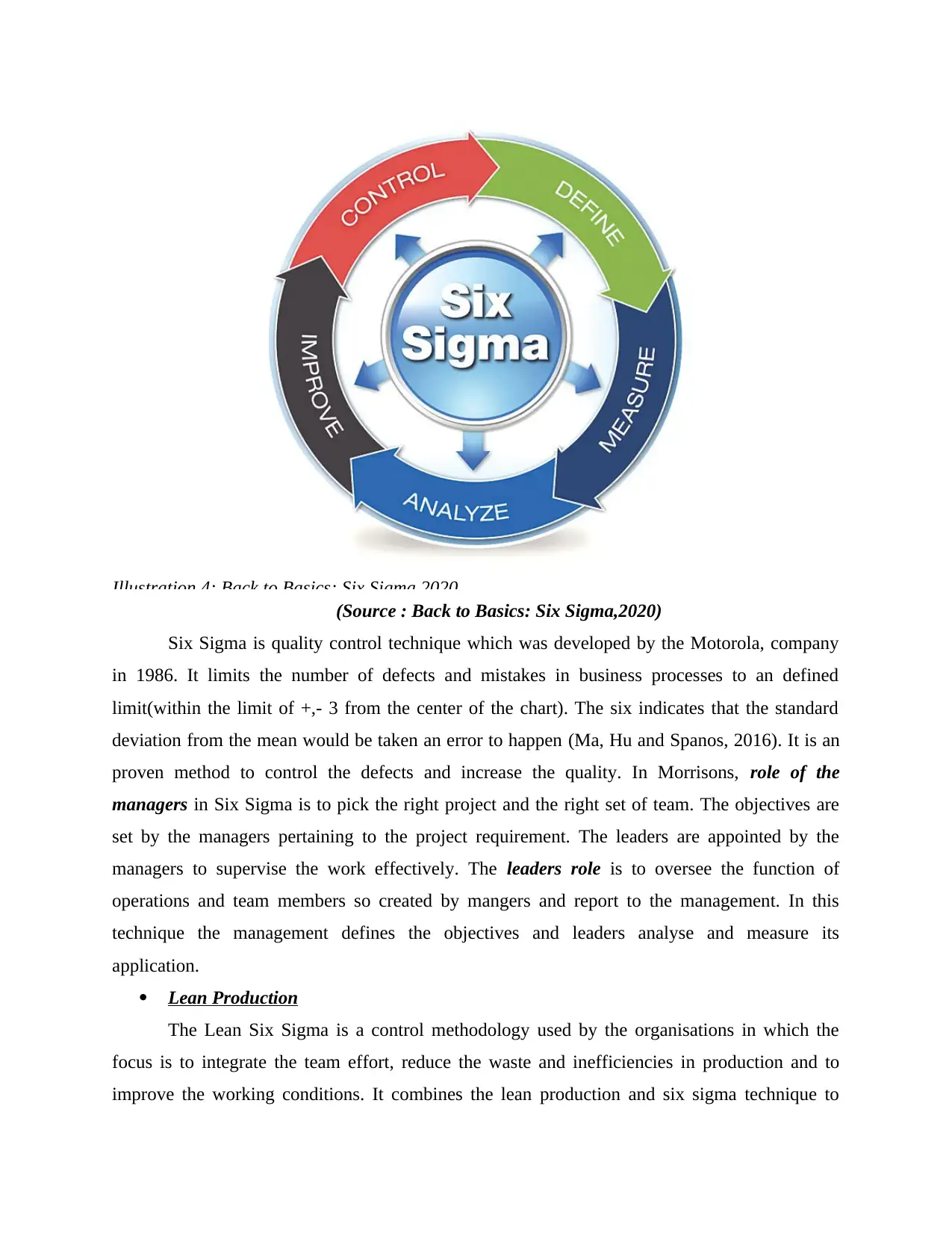
Illustration 4: Back to Basics: Six Sigma,2020
(Source : Back to Basics: Six Sigma,2020)
Six Sigma is quality control technique which was developed by the Motorola, company
in 1986. It limits the number of defects and mistakes in business processes to an defined
limit(within the limit of +,- 3 from the center of the chart). The six indicates that the standard
deviation from the mean would be taken an error to happen (Ma, Hu and Spanos, 2016). It is an
proven method to control the defects and increase the quality. In Morrisons, role of the
managers in Six Sigma is to pick the right project and the right set of team. The objectives are
set by the managers pertaining to the project requirement. The leaders are appointed by the
managers to supervise the work effectively. The leaders role is to oversee the function of
operations and team members so created by mangers and report to the management. In this
technique the management defines the objectives and leaders analyse and measure its
application.
Lean Production
The Lean Six Sigma is a control methodology used by the organisations in which the
focus is to integrate the team effort, reduce the waste and inefficiencies in production and to
improve the working conditions. It combines the lean production and six sigma technique to
(Source : Back to Basics: Six Sigma,2020)
Six Sigma is quality control technique which was developed by the Motorola, company
in 1986. It limits the number of defects and mistakes in business processes to an defined
limit(within the limit of +,- 3 from the center of the chart). The six indicates that the standard
deviation from the mean would be taken an error to happen (Ma, Hu and Spanos, 2016). It is an
proven method to control the defects and increase the quality. In Morrisons, role of the
managers in Six Sigma is to pick the right project and the right set of team. The objectives are
set by the managers pertaining to the project requirement. The leaders are appointed by the
managers to supervise the work effectively. The leaders role is to oversee the function of
operations and team members so created by mangers and report to the management. In this
technique the management defines the objectives and leaders analyse and measure its
application.
Lean Production
The Lean Six Sigma is a control methodology used by the organisations in which the
focus is to integrate the team effort, reduce the waste and inefficiencies in production and to
improve the working conditions. It combines the lean production and six sigma technique to
Paraphrase This Document
Need a fresh take? Get an instant paraphrase of this document with our AI Paraphraser
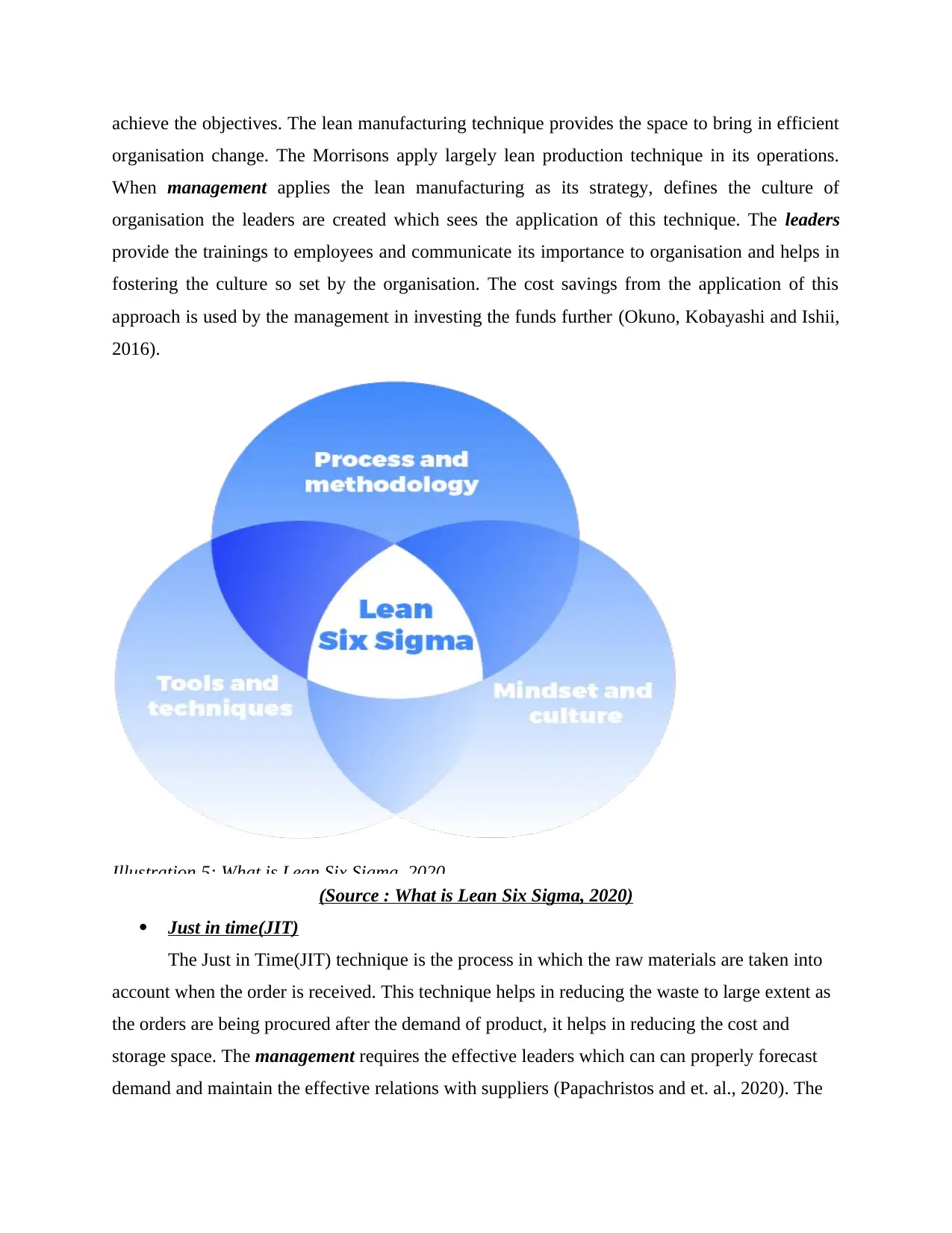
achieve the objectives. The lean manufacturing technique provides the space to bring in efficient
organisation change. The Morrisons apply largely lean production technique in its operations.
When management applies the lean manufacturing as its strategy, defines the culture of
organisation the leaders are created which sees the application of this technique. The leaders
provide the trainings to employees and communicate its importance to organisation and helps in
fostering the culture so set by the organisation. The cost savings from the application of this
approach is used by the management in investing the funds further (Okuno, Kobayashi and Ishii,
2016).
Illustration 5: What is Lean Six Sigma, 2020
(Source : What is Lean Six Sigma, 2020)
Just in time(JIT)
The Just in Time(JIT) technique is the process in which the raw materials are taken into
account when the order is received. This technique helps in reducing the waste to large extent as
the orders are being procured after the demand of product, it helps in reducing the cost and
storage space. The management requires the effective leaders which can can properly forecast
demand and maintain the effective relations with suppliers (Papachristos and et. al., 2020). The
organisation change. The Morrisons apply largely lean production technique in its operations.
When management applies the lean manufacturing as its strategy, defines the culture of
organisation the leaders are created which sees the application of this technique. The leaders
provide the trainings to employees and communicate its importance to organisation and helps in
fostering the culture so set by the organisation. The cost savings from the application of this
approach is used by the management in investing the funds further (Okuno, Kobayashi and Ishii,
2016).
Illustration 5: What is Lean Six Sigma, 2020
(Source : What is Lean Six Sigma, 2020)
Just in time(JIT)
The Just in Time(JIT) technique is the process in which the raw materials are taken into
account when the order is received. This technique helps in reducing the waste to large extent as
the orders are being procured after the demand of product, it helps in reducing the cost and
storage space. The management requires the effective leaders which can can properly forecast
demand and maintain the effective relations with suppliers (Papachristos and et. al., 2020). The
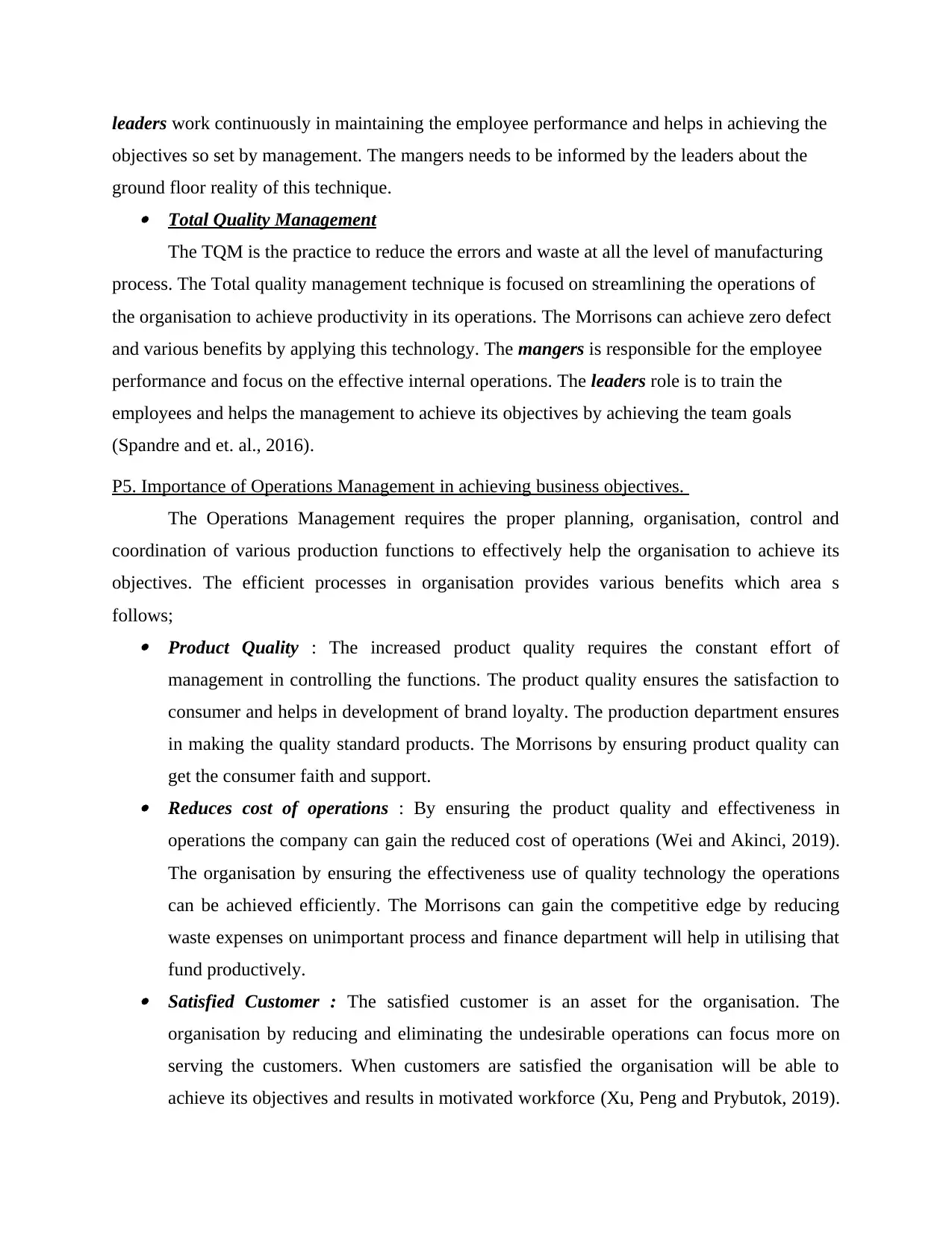
leaders work continuously in maintaining the employee performance and helps in achieving the
objectives so set by management. The mangers needs to be informed by the leaders about the
ground floor reality of this technique. Total Quality Management
The TQM is the practice to reduce the errors and waste at all the level of manufacturing
process. The Total quality management technique is focused on streamlining the operations of
the organisation to achieve productivity in its operations. The Morrisons can achieve zero defect
and various benefits by applying this technology. The mangers is responsible for the employee
performance and focus on the effective internal operations. The leaders role is to train the
employees and helps the management to achieve its objectives by achieving the team goals
(Spandre and et. al., 2016).
P5. Importance of Operations Management in achieving business objectives.
The Operations Management requires the proper planning, organisation, control and
coordination of various production functions to effectively help the organisation to achieve its
objectives. The efficient processes in organisation provides various benefits which area s
follows; Product Quality : The increased product quality requires the constant effort of
management in controlling the functions. The product quality ensures the satisfaction to
consumer and helps in development of brand loyalty. The production department ensures
in making the quality standard products. The Morrisons by ensuring product quality can
get the consumer faith and support. Reduces cost of operations : By ensuring the product quality and effectiveness in
operations the company can gain the reduced cost of operations (Wei and Akinci, 2019).
The organisation by ensuring the effectiveness use of quality technology the operations
can be achieved efficiently. The Morrisons can gain the competitive edge by reducing
waste expenses on unimportant process and finance department will help in utilising that
fund productively. Satisfied Customer : The satisfied customer is an asset for the organisation. The
organisation by reducing and eliminating the undesirable operations can focus more on
serving the customers. When customers are satisfied the organisation will be able to
achieve its objectives and results in motivated workforce (Xu, Peng and Prybutok, 2019).
objectives so set by management. The mangers needs to be informed by the leaders about the
ground floor reality of this technique. Total Quality Management
The TQM is the practice to reduce the errors and waste at all the level of manufacturing
process. The Total quality management technique is focused on streamlining the operations of
the organisation to achieve productivity in its operations. The Morrisons can achieve zero defect
and various benefits by applying this technology. The mangers is responsible for the employee
performance and focus on the effective internal operations. The leaders role is to train the
employees and helps the management to achieve its objectives by achieving the team goals
(Spandre and et. al., 2016).
P5. Importance of Operations Management in achieving business objectives.
The Operations Management requires the proper planning, organisation, control and
coordination of various production functions to effectively help the organisation to achieve its
objectives. The efficient processes in organisation provides various benefits which area s
follows; Product Quality : The increased product quality requires the constant effort of
management in controlling the functions. The product quality ensures the satisfaction to
consumer and helps in development of brand loyalty. The production department ensures
in making the quality standard products. The Morrisons by ensuring product quality can
get the consumer faith and support. Reduces cost of operations : By ensuring the product quality and effectiveness in
operations the company can gain the reduced cost of operations (Wei and Akinci, 2019).
The organisation by ensuring the effectiveness use of quality technology the operations
can be achieved efficiently. The Morrisons can gain the competitive edge by reducing
waste expenses on unimportant process and finance department will help in utilising that
fund productively. Satisfied Customer : The satisfied customer is an asset for the organisation. The
organisation by reducing and eliminating the undesirable operations can focus more on
serving the customers. When customers are satisfied the organisation will be able to
achieve its objectives and results in motivated workforce (Xu, Peng and Prybutok, 2019).
⊘ This is a preview!⊘
Do you want full access?
Subscribe today to unlock all pages.

Trusted by 1+ million students worldwide
1 out of 16
Related Documents
Your All-in-One AI-Powered Toolkit for Academic Success.
+13062052269
info@desklib.com
Available 24*7 on WhatsApp / Email
![[object Object]](/_next/static/media/star-bottom.7253800d.svg)
Unlock your academic potential
Copyright © 2020–2025 A2Z Services. All Rights Reserved. Developed and managed by ZUCOL.





